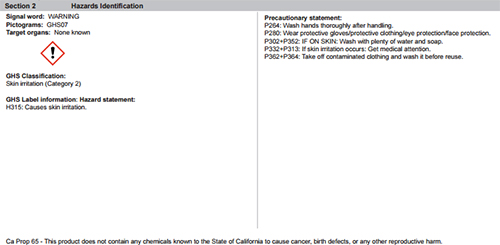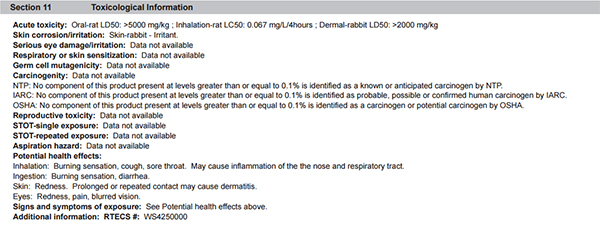How to Read & Use an SDS
Section 1: Company and Product IdentificationThis section indicates the product name as it appears on the container label. This section must also have the name, address and telephone number of the manufacturer or distributor, along with an emergency phone number. In some cases, the SDS may include commonly-used trade names, synonyms, and material uses. A 24-hour emergency assistance Chemical Transportation Emergency Center (CHEMTREC) phone number is listed for the purpose of reporting significant emergency spills where chemicals are being transported.
Section 2: Hazard(s) IdentificationThis section identifies hazards associated with the listed chemical, along with any necessary warnings for those hazards. GHS requires Hazard Communication Standard (HCS) pictograms be used to convey a chemical's distinct hazards. HCS pictograms consist of a symbol on a white background framed by a red border. The nine pictograms and hazards, as described by OSHA can be found on the OSHA website here. An SDS is required to list:
Section 3: Composition/Information on IngredientsThis section identifies the ingredients of chemicals, substances, and mixtures contained in the item associated on the SDS. Information found in Section 3 includes, chemical/substance/mixture name, synonyms, Chemical Abstract Service (CAS) number, impurities, additives, and concentration.
Section 4: First Aid MeasuresThis section gives instructions for untrained responders to provide immediate care in case of an accident. First-aid instructions are given for each possible route of exposure, along with immediate, acute and delayed symptoms. Recommendations for further treatment are given when necessary.
Section 5: Fire Fighting MeasuresThis section provides information about how to fight a potential fire. Recommendations for suitable extinguishing equipment are provided, along with information about any equipment that should NOT be used to fight the fire. This section also provides information about any specific hazards that may occur, such as hazardous combustion, and protective equipment that should be worn while fighting the fire.
Section 6: Accidental Release MeasuresThis section provides information for responding to spills, leaks, and releases to minimize exposure to people, the environment, and property. Information will include:
Section 7: Handling and StorageThis section contains tips for the safe handling and storage of chemicals. Safe handling recommendations include storage and handling of incompatible chemicals, how to minimize risk of spills, leaks, or releases into environment, and hygiene tips. Safe storage recommendations include chemical incompatibility and special storage instructions, such as ventilation.
Section 8: Exposure Controls/Personal ProtectionThis section explains exposure limits and how to protect yourself while handling the chemical. OSHA Permissible Exposure Limits (PELs) and any other appropriate exposure limit information are provided. This section lists any personal protective equipment (PPE) recommendations, along with equipment specifications and limitations. There will also be a list of any necessary engineering controls, such as the need for ventilation.
Section 9: Physical and Chemical PropertiesThis section provides information on physical and chemical properties of the listed chemical. A SDS must contain the following information where applicable:
Section 10: Stability and ReactivityThis section identifies chemical stability, reactivity and other hazard information. Chemical stability information is provided for ambient conditions while a chemical is being stored or handled. If a chemical stabilizer is necessary or if changes in physical appearance indicate a hazard, this information will also be provided. Reactivity information will include incompatible chemicals and conditions that could potentially cause a hazardous reaction.
Section 11: Toxicology InformationThis section explains toxicological and health effects that could occur if chemical exposure occurs. This section is required to reveal:
Section 12: Ecological InformationThis section contains environmental impact information should the chemical be released into the environment. The data given may include:
Section 13: Disposable ConsiderationsThis section provides chemical disposal, recycling, and reclamation guidance for the chemicals and its container. This may include proper disposal container use, appropriate disposal methods, any physical or chemical properties that may affect disposal, discouragement of sewage disposal, and special precautions for landfill or incarnation disposal methods. This section may refer to Section 8 of the SDS (Exposure Control/Personal Protection). Section 13 is a non-mandatory section.
Section 14: Transport Information (US DOT / Canada TGD)This section includes classifications for shipping and transporting the chemical provided by USDOT and Transport Canada, along with any special precautions that should be taken when shipping the chemical.
Section 15: Regulatory InformationThis section provides information about safety, health, and environmental regulations not located in other sections of the SDS. This will include national and regional regulations that apply to the chemical.
Section 16: Additional InformationThis section provides information on when the SDS was created and/or the data of the last revision. There may also be details on what has changed since the previous version was released. Any other information the manufacturer wishes to convey that does not fit into other sections will be included in this section.
|





















